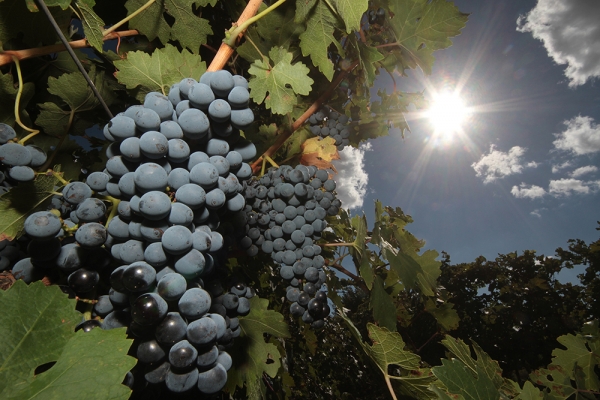
Muscat grapes occupy a special place among grape varieties; they are an aristocracy in the world of wine making. Most likely, just one of them was the “ancestor” of all cultivated wine berries. The characteristic musky smell and deep taste make muscat grapes especially revered by breeders. At the moment, varieties with high immunity have already been bred, however, old capricious elite species have been preserved. Those and others have their own characteristics, which can be learned through descriptions and photos.
Content
Features of Muscat grapes
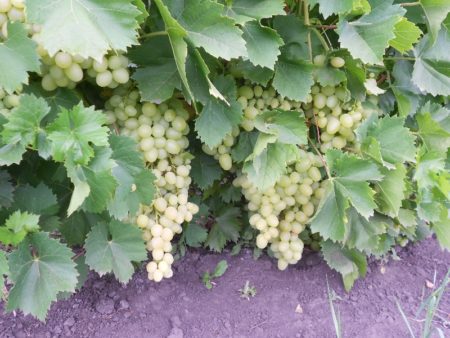
Muscat grapes began their journey from the fertile lands of Syria, Egypt, Rome and Greece several millennia ago. The first written evidence dates back to the VIII-VI centuries BC. - Homer and Hesiod mentioned honey to the taste of wine. In those days they did not know how to make alcohol, and the strength of the wine depended on the sugar content in the grapes themselves. Therefore, the unusually sweet muscat was especially appreciated, but even the vines were twisted additionally, the leaves were torn off, and then the berries were dried in the sun to evaporate excess moisture.
Since 1828, nutmegs began to be grown on the lands of the Crimean peninsula. Later it spread to the southern outskirts of the Russian Empire. At this time, he can be found in the Stavropol and Krasnodar Territories of the Russian Federation, Ukraine, Turkmenistan, Moldova, Dagestan. But the largest plantations are located in Portugal, Spain, Italy and France.
Muscat grapes are characterized by a high content of phytoncides, which have a beneficial effect on the natural bacterial balance of the intestine. The berries are large, fleshy with a small number of seeds (2-3 pieces), the skin is translucent, delicate. The musky taste and smell of the grapes is given by the thorn-like compounds found in the skin, as well as the fruit pulp adjacent to it.
Best Muscat Grape Varieties
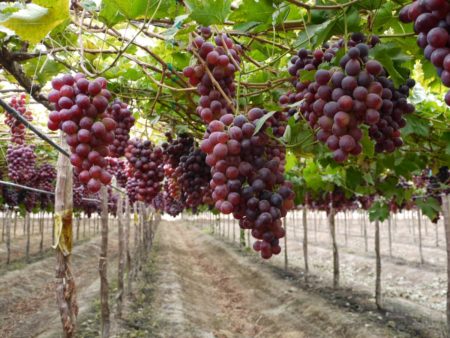
Earlier, nutmeg grapes were grown only in warm regions, as it was not resistant to cold and fungi. Now there are hybrids adapted to different climatic conditions. Including there are grape varieties for the middle band. Breeders were able to bring berries with a high sugar content, more developed immunity and high productivity, which allows you to choose a variety for your needs.
Pink
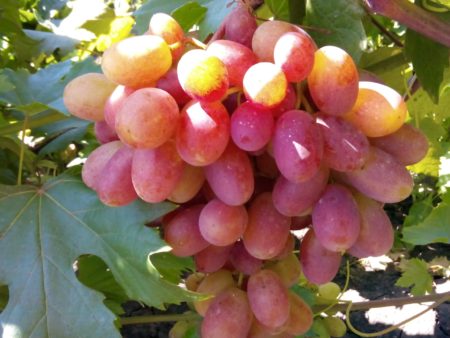
Pink nutmeg grapes were bred 200 years ago. The shoots have a red tint, but turn yellow by the time of harvest, the leaves are large, rounded, the shape of the bunch is cylindrical, its weight is 120-200 g, the flowers are bisexual.
Pink nutmeg ripens in 4.5 months. With the accumulation of juices, the berries darken from pale lilac with a slight white bloom to dark purple, almost black. In shape they are round, large. The sugar content is 25-35%. The vine has an average growth rate, does not need regular pruning.
The variety is not demanding on the composition of the soil, able to tolerate frosts of -25 degrees Celsius in winter. For ripening, it needs warm, dry weather, watering should not exceed 4-5 times, that is, in fact, there will be enough rain. But if the summer season is rich in rainfall, then the grapes can rot.
The immunity of pink muscat is rather weak, it is susceptible to oidium, phylloxera, mildew, spider mite, leafworm, phylloxera.
Summer
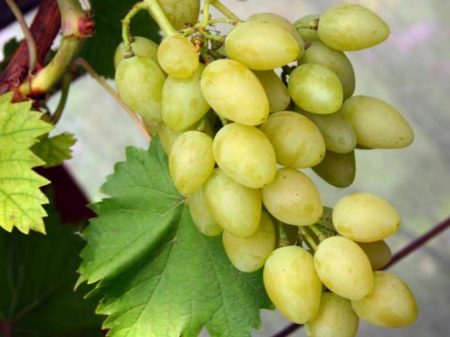
It is a fast-growing shrub with powerful shoots, large elongated clusters. The weight of the latter can reach 700 g.
The berries are light green with an amber tint and white bloom (the brightness of the color depends on the degree of illumination of the vine). Their shape is oval elongated slightly pointed at the end. Sugar content can reach 20%.
The variety has excellent indicators for growing in central Russia. It is able to withstand frosts down to -27 degrees Celsius (when covered), abrupt changes in climatic conditions, quickly sings, has very high yields, is not susceptible to fungi, mildew. Of the diseases, chlorosis and bacterial cancer are dangerous to him, sometimes it can be spoiled by oidium or root phylloxera.
Super red
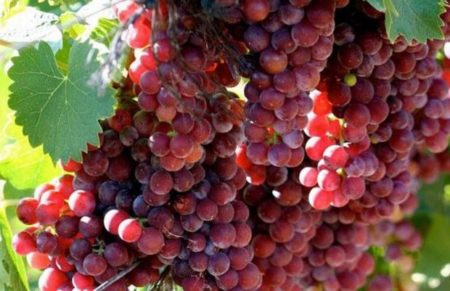
The Moldovan variety Super-Red has a unique combination of qualities. It is a super-early grape with an average yield, ripens in 3-3.5 months, so the harvest can begin in July, it is frost-resistant, in addition, it has excellent marketability:
- calmly undergoing transportation;
- stored without losing taste until 12 weeks;
- the sugar content is not more than 20%, so the berries do not attract wasps, do not ripen, do not rot for a long time.
Based on the name, it is clear that grapes have a red color, but gradually acquire a purple hue. In shape they are large round, form cylindrical clusters weighing up to 400 g. The shoots are also red, the leaves are bright green, cover the vine abundantly. The relatively low sugar content makes this nutmeg the best choice for making table wines.
Super-red grapes are not completely susceptible to gray rot; mildew and oidium represent a small danger. Good immunity and the ability to ripen quickly protect the berries from most fungi and diseases.
Novoshakhtinsky
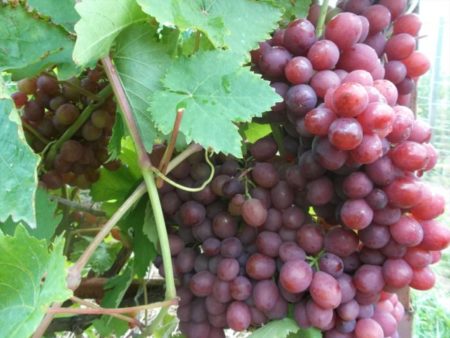
Muscat belongs to early ripening (it begins to be harvested in the first ten days of August) and high-yielding varieties. The flowers are self-pollinated, almost 100% of the ovaries ripen, and one bunch can weigh up to 600 g. The berries are large, purple with a red tint and a faint white coating, they have 1-3 seeds, the skin is thin. Sugar content reaches 30%.
Novoshakhtinsky grapes are resistant to frost, calmly tolerates transportation, stored for a long time, and have medium resistance to mildew and oidium, and the diseases usually affect the leaves, not the fruits. A characteristic feature of the variety is its adaptability to unstable weather conditions; it calmly tolerates rainy summers.
Russian
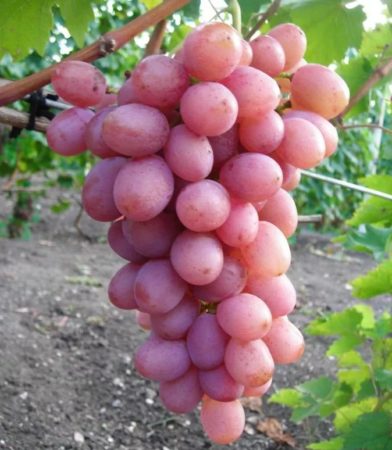
Refers to early ripe nutmegsripens in 3-3.5 months, so the harvest is already in July. Its main advantage is called strong immunity, which protects the fruits from all diseases.
The berries are large, round, with a white coating, red-orange, pink or purple flowers, depending on the degree of ripening. They form large conical clusters weighing up to 600 g, which allows you to collect high yields from one bush - 20-25 kg.
Livadia
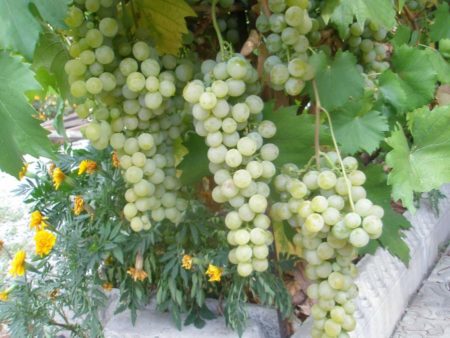
Variety Livadia is the best option for starting grape production. He is thermophilic, like most nutmegs, but is able to withstand frosts down to -20 degrees Celsius. He is also not afraid of drought. Strong immunity protects Livadia from infections and fungi that infect other vines. And thanks to the dense skin, wasps cannot bite through the fruits.
The bushes are not tall, they do not need pruning, there is not much foliage, the flowers are bisexual, they do not need additional pollination. Grapes Livadia prefers loams or sandstones, but feels good on other soils.
The maximum sugar content is only 19%, but may be less if the berries had little sunlight in the summer.
The productivity of Livadia is high: one bunch weighs from 500 g to 800 g, has a conical elongated shape. The grapes are not large, oval, light green in color with amber tint and barely noticeable white coating.
Donskoy
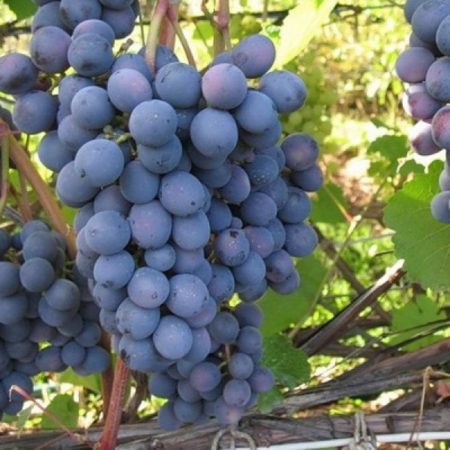
The variety has many strengths and weaknesses. The first can be attributed to a sugar content of 30% and high productivity. Donskoy grows well on any soil, frost-resistant - can withstand up to -30 degrees Celsius.
But with a large number of ovaries, only 50% ripens, and the berries are very small. To increase their size, you need to thin out the brush. The color of the grapes is dark purple with a slight white bloom, the shape is round. Immunity is average, for Donskoy the most dangerous is phylloxera.
Pleven
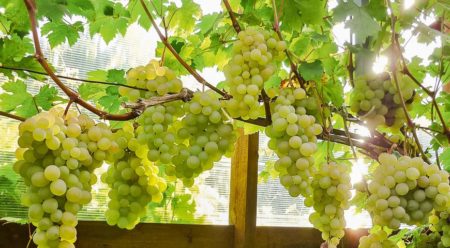
The Bulgarian variety Pleven ripens in 4 months. The yield is higher than that of the previous grapes and is 80-85%, and the weight of one bunch can reach 600 g. The berries are large, oval, amber in color with a green tint with a sugar content of 20%.
For Russia, Pleven is useful for its frost resistance, it quietly withstands temperatures of -25 degrees Celsius. In addition, the variety has good immunity and is virtually immune to fungal infections.
Blau
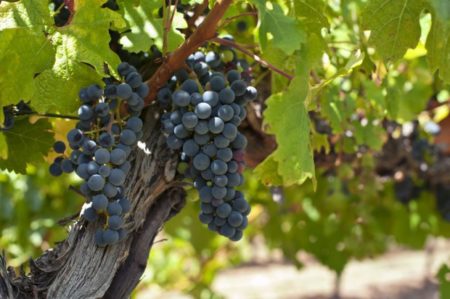
The Blau variety was bred in Switzerland. The resulting grapes are able to survive the frost to -30 degrees Celsius, ripens in 3.5-4 months. It is quite resistant to diseases and fungi, but nevertheless it is recommended to carry out preventive spraying with phytoncides to the fruit's ovary.
The clusters are small, their weight is not more than 300 g, the berries are round, medium-sized, purple. The grape yield is high, but to improve the quality, the vine should be cut. The composition of the soil, the amount of sunlight for Blau does not matter, however, he needs fertilizers and abundant watering.
The main minus of the variety is a thin peel, which makes the fruits an easy target for wasps. To protect the berries, the bushes should be covered with a fine-grained mesh, and insect traps should be placed nearby.
White

This is one of the elite oldest varieties among nutmegs. He needs loamy, well-drained soil. Perfectly suitable rocky open southern slope. Of fertilizers, prefers potash.
The white grape variety is characterized by early ripeness and average yield, it is harvested in the third decade of September, when the sugar content reaches its maximum value. On average, its rate should be 30% by weight of the berry.
The weight of one bunch can be 450 g, but usually ranges from 110-120 g. The ripening period is 4-5 months. The vine grows quickly, so it must be pruned.
White nutmeg difficult to care for, he is very thermophilic, unable to survive even short-term droughts, invasions of pests and fungi.
Buffet
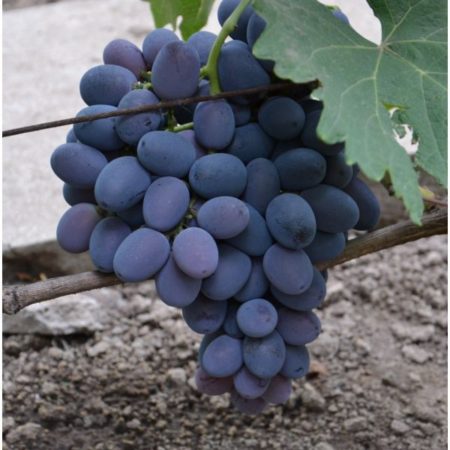
The Muscat Furshetny ripens in 4 months, has an excellent yield, one bunch of it can reach 800 g. The berries are dark purple, large, oval, with a bluish bloom. The variety is stored for a long time, tolerates transportation well, withstands a temperature drop of -23 degrees Celsius.
Buffet grapes are medium resistant to fungi, in order to protect the crop, it is recommended to carry out two sprayings, one before flowering and the other after it. Gray rot and wasps are not scary for this muscat.
Long awaited
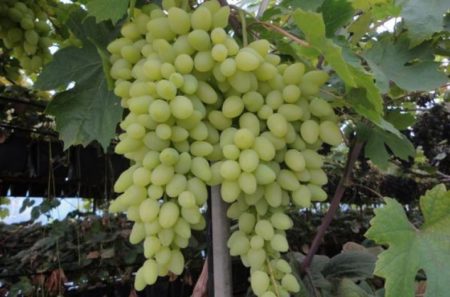
The variety belongs to the early ripening, it ripens in 3.5 months. The clusters are large, cone-shaped, weight can reach 1,500 g. The grapes are elongated, oval, light green in color with amber tint, in the unripe state they are white.Their characteristic feature is that some berries have seeds, and the other are missing. The flowers are bisexual, self-pollinated.
Long awaited frost-resistant, but to preserve the vine, it needs to be sheltered for the winter. Resistance to fungi and diseases is high, it is recommended to carry out one spraying volatile before flowering.
The variety is well stored, lends itself well to cuttings. For planting, it is better to choose a sunny place, and to add organic fertilizers to the hole.
Amur
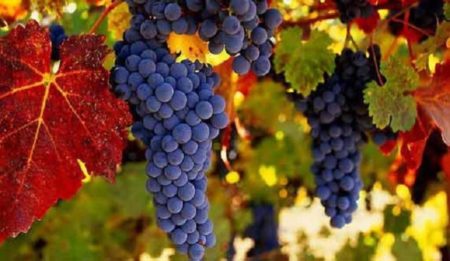
Amur grapes belong to the old Muscat of Asian origin. According to legend, it was discovered near the Amur River, and the name of berries came from it. A distinctive feature of the variety is the rapid shoot formation.
Otherwise, this nutmeg is unpretentious, develops rapidly, gives high yields. The main advantage of the variety is its unique frost resistance, it is able to survive a temperature of -40 degrees Celsius.
Amur blooms in May, and harvesting takes place in September. By this time, the bark and leaves are turning red, and the berries are darkening from orange-red to dark purple with a bluish bloom. The weight of one bunch can be 250-300 g.
The weak point of grapes is their low resistance to diseases, therefore it must be regularly sprayed with fungi, cancer and gray rot.
Hamburg
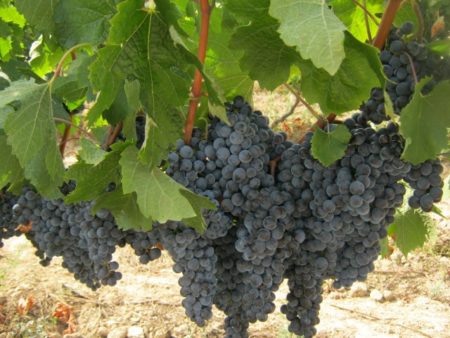
The Hamburg variety was bred in England; it is medium-late; it takes about 5 months to mature. Harvesting begins in the second decade of September, theoretically, nutmeg can produce large volumes of fruits, but sometimes they are much smaller than expected by winegrowers.
It is demanding on climatic conditions, needs heat and sun, does not tolerate frosts, so the bushes should be tightly covered for the winter.
Immunity is weak, grapes often suffer from gray rot, oidium, mildew and phylloxera.
Otherwise, this variety is also called Black Muscat, because its berries have a dense dark purple, almost black color. There are 2-3 bones in them. The clusters are conical in shape, loose, small, their weight barely reaches 260 g, while the grapes themselves are large, round with a hard skin.
The strengths of Hamburg Muscat include excellent transportability and ability to be stored for about 3 months.
Noble
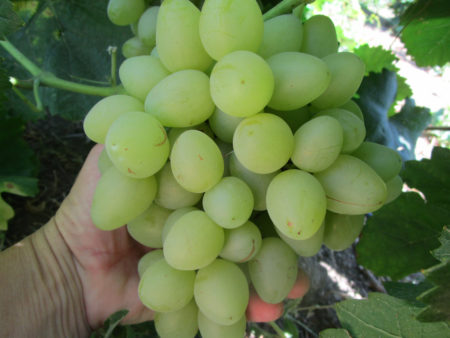
A good example of a strong hybrid variety. Noble gives high yields, one bunch weighs an average of 600 g. In shape, it is conical, loose, the berries are very large (3-4 cm in length), light green, yellow, translucent. Grapes ripening occurs in 3.5-4 months.
Frost resistance is average, it can withstand temperatures of -23 degrees Celsius, but it is better to cover bushes for the winter. The immunity is mediocre, it is recommended to carry out several sprayings per season.
Of the undoubted advantages for winegrowers, one can single out the ability of the variety to survive long transportation, as well as the indifference of wasps to it.
Moscow
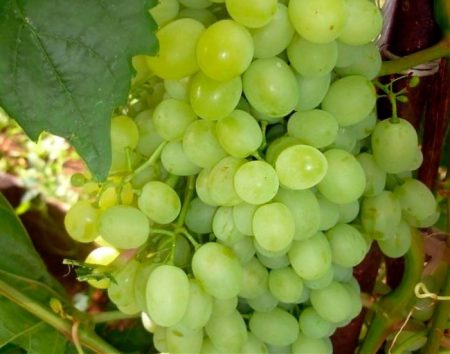
it early grapes, its ripening period is slightly less than 4 months. It features high frost resistance - can withstand up to -30 degrees Celsius. In fact, Moskovsky is a hybrid of the Amur variety, was bred in Russia and has taken root well in summer cottages at amateur winegrowers.
The bush grows quickly, there is not much green mass, clusters are small, of various shapes, the berries are light green, small with 4-5 seeds inside. But the taste is sweet with a slight acidity. The sugar content is 17-17.5%. The weight of one brush reaches an average of 250 g, but can reach 470 g.
Immunity is not able to protect the plant, so it needs to be sprayed.The soil for Moscow grapes requires loose and sour, it is better to plant on the southern sunny side.
Reviews
Valeria
Not professionally engaged in grape cultivation, however, flattered by the Hamburg variety. In terms of taste, it is magnificent: very sweet and juicy. But in leaving, I got tired of it: to shelter in the fall, to check in the winter (I live in the Rostov region), to spray in the spring, to save from wasps in the summer. Not sure if it's worth it. Although homemade wine is thick, saturated color, almost liquor. But the juices are too sweet, mixed with the juice of late apples and only so gave children.
Maksim
My favorite variety is Pink Nutmeg. Tasty, sweet, unpretentious. The main thing is not to plant in alumina and spray on time. I also conduct additional pollination. To do this, during flowering with a brush, I collect pollen in a plate, mix, and then put it on the flowers again. The variety can easily withstand a large number of ovaries. I recommend dripping watering so that it does not start to rot.
Muscat grapes are distinguished by a variety of characteristics, but all of them are characterized by sweetness, original taste and musky smell. Old subspecies have weaker immunity and less frost resistance, but they continue to be bred in Europe to make many wines beloved by many. Young strong varieties will fully satisfy the needs of winegrowers living in central Russia; you can also get excellent drinks, preserves or just eat fresh berries from them.




 Non-covering winter-hardy grape varieties for Moscow region
Non-covering winter-hardy grape varieties for Moscow region How to keep the vine in winter
How to keep the vine in winter When can I transfer grapes to another place in the fall
When can I transfer grapes to another place in the fall How to cover and prepare grapes for the winter in the suburbs
How to cover and prepare grapes for the winter in the suburbs